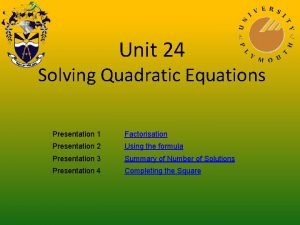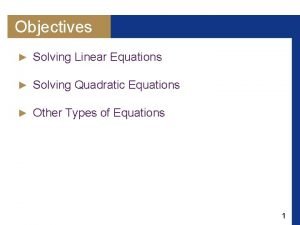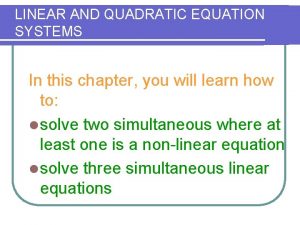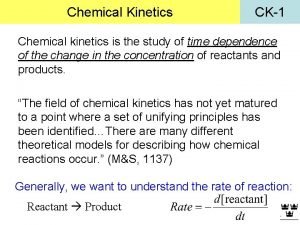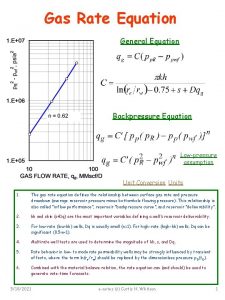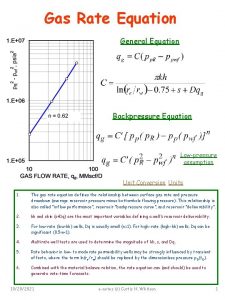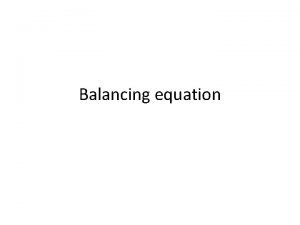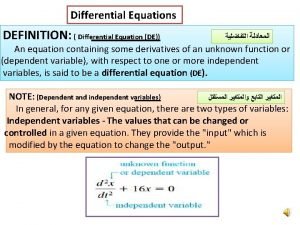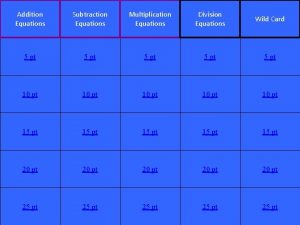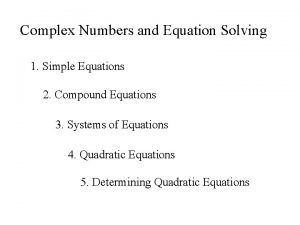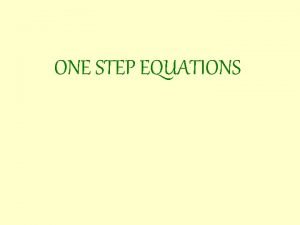PRESENTATION 13 Simple Equations EQUATIONS An equation is

























- Slides: 25

PRESENTATION 13 Simple Equations

EQUATIONS • An equation is a mathematical statement of equality between two or more quantities • It always contains an equal sign • A formula is a particular type of equation that states a mathematical rule

WRITING EQUATIONS • The following examples illustrate writing equations from given word statements • A number plus 20 equals 35: • Let n = the number The equation would become: n + 20 = 35 • Four times a number equals 40: • • Let x = the number Four times the number would then be 4 x The equation is now: 4 x = 40

SUBTRACTION PRINCIPLE OF EQUALITY • The subtraction principle of equality states: • • If the same number is subtracted from both sides of an equation, the sides remain equal The equation remains balanced

SUBTRACTION PRINCIPLE OF EQUALITY • Procedure for solving an equation in which a number is added to the unknown: • Subtract the number that is added to the unknown from both sides of the equation

SUBTRACTION PRINCIPLE OF EQUALITY • Example: • Solve x + 5 = 12 for x: In the equation, the number 5 is added to x so subtract 5 from both sides to solve for x x + 5 = 12 – 5 x = 7

ADDITION PRINCIPLE OF EQUALITY • The addition principle of equality states: • • If the same number is added to both sides of an equation, the sides remain equal The equation remains balanced

ADDITION PRINCIPLE OF EQUALITY • Procedure for solving an equation in which a number is subtracted from the unknown • • Add the number, which is subtracted from the unknown, to both sides of an equation The equation maintains its balance

ADDITION PRINCIPLE OF EQUALITY • Example: Solve for y: • y – 7 = 10 In the equation, the number 7 is subtracted from y, so add 7 to both sides y – 7 = 10 + 7 +7 y = 17

DIVISION PRINCIPLE OF EQUALITY • The division principle of equality states: • • If both sides of an equation are divided by the same number, the sides remain equal The equation remains balanced

DIVISION PRINCIPLE OF EQUALITY • Procedure for solving an equation in which the unknown is multiplied by a number: • • Divide both sides of the equation by the number that multiplies the unknown The equation maintains its balance

DIVISION PRINCIPLE OF EQUALITY • Example: Solve for x: 6 x = 30 • In the equation, x is multiplied by 6, so divide both sides by 6 x=5

MULTIPLICATION PRINCIPLE OF EQUALITY • The multiplication principle of equality states: • • If both sides of an equation are multiplied by the same number, the sides remain equal The equation remains balanced

MULTIPLICATION PRINCIPLE OF EQUALITY • Procedure for solving an equation in which the unknown is divided by a number: • • Multiply both sides of the equation by the number that divides the unknown Equation maintains in balance

MULTIPLICATION PRINCIPLE OF EQUALITY • Example: Solve for y: • In the equation, y is divided by 3, so multiply both sides by 3 y = 15

ROOT PRINCIPLE OF EQUALITY • The root principle of equality states: • • If the same root of both sides of an equation is taken, the sides remain equal The equation remains balanced

ROOT PRINCIPLE OF EQUALITY • Procedure for solving an equation in which the unknown is raised to a power: • • Extract the root of both sides of the equation that leaves the unknown with an exponent of 1 Equation maintains in balance

ROOT PRINCIPLE OF EQUALITY • Example: Solve for x: • 2 x = 25 In the equation, x is squared, so to solve the equation, extract the square root of both sides x=5

POWER PRINCIPLE OF EQUALITY • The power principle of equality states: • • If both sides of an equation are raised to the same power, the sides remain equal The equation remains balanced

POWER PRINCIPLE OF EQUALITY • Procedure for solving an equation which contains a root of the unknown: • • Raise both sides of the equation to the power that leaves the unknown with an exponent of 1 Equation maintains in balance

POWER PRINCIPLE OF EQUALITY • Example: Solve for y: • • In the equation, y is expressed as a square root, so to solve the equation, square both sides (√y)2 = (3)2 y=9

PRACTICAL PROBLEMS • A company’s profit for the second half year is $150, 000 greater than the profit for the first half year • The total annual profit is $850, 000 • What is the profit for the first half year and the second half of the year?

PRACTICAL PROBLEMS • Let P equal the profit for the first half year • Then P + $150, 000 is the profit for the • • second half year The sum is $850, 000 Set up an equation: • P + $150, 000 = $850, 000 Sum like terms: 2 P + $150, 000 = $850, 000

PRACTICAL PROBLEMS • Use the subtraction principle of equality and subtract $150, 000 from both sides: 2 P + $150, 000 – $150, 000 = $850, 000 – $150, 000 2 P = $700, 000 • Use the division principle of equality and divide both sides by 2 2 P ÷ 2 = $700, 000 ÷ 2 P = $350, 000

PRACTICAL PROBLEMS • The profit for the first half year is $350, 000 • The profit for the second half year is $350, 000 + $150, 000 = $500, 000 • Check: Total profit is $350, 000 + $500, 000, which equals $850, 000
 Future simple in the past
Future simple in the past Present simple past simple future simple
Present simple past simple future simple Past simple future
Past simple future Present simple present continuous past simple future simple
Present simple present continuous past simple future simple Simple present, simple past, simple future
Simple present, simple past, simple future Present continuous vs future simple exercises
Present continuous vs future simple exercises Rules of tense
Rules of tense Definition present simple
Definition present simple Future simple present simple
Future simple present simple 5cm labor
5cm labor Vertex presentation
Vertex presentation Quadratic equation presentation
Quadratic equation presentation Single displacement general equation
Single displacement general equation Eyring equation and arrhenius equation
Eyring equation and arrhenius equation Linear equation and quadratic equation
Linear equation and quadratic equation Linear equation and quadratic equation
Linear equation and quadratic equation Equation of fluid
Equation of fluid Exact differential equation
Exact differential equation Vmax= k2et
Vmax= k2et Rate law units
Rate law units Pb(no3)2 + ki
Pb(no3)2 + ki Bernoulli differential equation formula
Bernoulli differential equation formula Rewrite the absolute value equation as two linear equations
Rewrite the absolute value equation as two linear equations Rewrite the absolute value equation as two linear equations
Rewrite the absolute value equation as two linear equations Polar to rectangular equation
Polar to rectangular equation Translate word equations to chemical equations
Translate word equations to chemical equations











